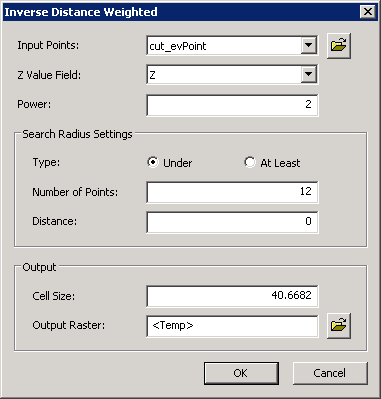IDW
Inverse distance weighted (IDW) interpolation estimates the unknown cell values with the combination of linearly weighted of a set of sample points. The weighted calculation is performed by the neighboring known value; the weight is a inverse distance function, because the weighted calculation, the distance of the neighboring point will influence the result(the farther distance has less influence). The function is as below:
In the function,
Distance Weight Parameter: Power The weight of estimated point is defined by the inverse distance; the more distance, the less influence. When the power is increased, the result will be influenced by distance greater.
Search Radius Parameter: Under The searching radius is determined by the number of point. That is, when the number of sample data points found in the searching range is smaller than the default number, the search radius will be expanded and keep searching until the number of points is met. Thus the density of the sampling points might cause the different searching radius in different area (the default number of point is 12). Besides, users can set the maximum searching radius(map unit). If the searching radius reaches the maximum distance before the number of points are obtained, the system will start to calculate the values of the found points within the maximum distance.
At Least The interpolation will be performed by restricting the search radius (map unit, the default search radius is five times the size of output cell). Or users can set to find a minimum number of point (at least). If the number of sample data points found in the searching range is smaller than the At-least number, the search radius will be expanded and keep search until the number of points found is equal to the setting (the default is 0).
Description of Parameters
©2016 Supergeo Technologies Inc. All rights reserved. |


